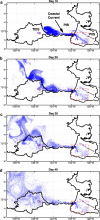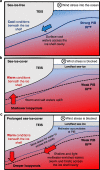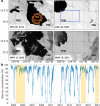Ocean variability beneath Thwaites Eastern Ice Shelf driven by the Pine Island Bay Gyre strength
- PMID: 36543787
- PMCID: PMC9772408
- DOI: 10.1038/s41467-022-35499-5
Ocean variability beneath Thwaites Eastern Ice Shelf driven by the Pine Island Bay Gyre strength
Abstract
West Antarctic ice-shelf thinning is primarily caused by ocean-driven basal melting. Here we assess ocean variability below Thwaites Eastern Ice Shelf (TEIS) and reveal the importance of local ocean circulation and sea-ice. Measurements obtained from two sub-ice-shelf moorings, spanning January 2020 to March 2021, show warming of the ice-shelf cavity and an increase in meltwater fraction of the upper sub-ice layer. Combined with ocean modelling results, our observations suggest that meltwater from Pine Island Ice Shelf feeds into the TEIS cavity, adding to horizontal heat transport there. We propose that a weakening of the Pine Island Bay gyre caused by prolonged sea-ice cover from April 2020 to March 2021 allowed meltwater-enriched waters to enter the TEIS cavity, which increased the temperature of the upper layer. Our study highlights the sensitivity of ocean circulation beneath ice shelves to local atmosphere-sea-ice-ocean forcing in neighbouring open oceans.
© 2022. The Author(s).
Conflict of interest statement
The authors declare that they have no conflict of interest.
Figures









References
-
- Mouginot J, Rignot E, Scheuchl B. Sustained increase in ice discharge from the Amundsen Sea Embayment, West Antarctica, from 1973 to 2013. Geophys. Res. Lett. 2014;41:1576–1584. doi: 10.1002/2013GL059069. - DOI
-
- Alley KE, et al. Two decades of dynamic change and progressive destabilization on the Thwaites Eastern Ice Shelf. Cryosphere. 2021;15:5187–5203. doi: 10.5194/tc-15-5187-2021. - DOI
-
- Wild CT, et al. Weakening of the pinning point buttressing Thwaites Glacier, West Antarctica. Cryosphere. 2022;16:397–417. doi: 10.5194/tc-16-397-2022. - DOI
Publication types
MeSH terms
Substances
LinkOut - more resources
Full Text Sources
Miscellaneous

